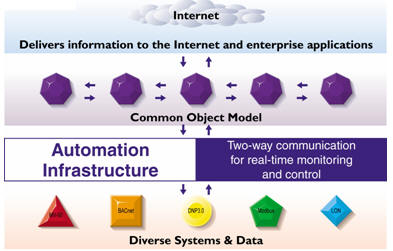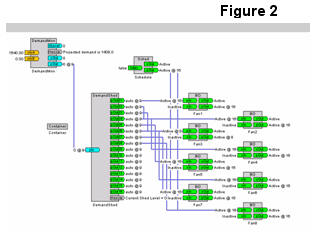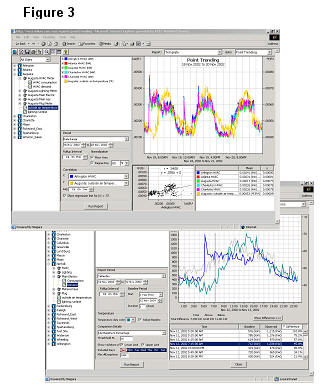August 2004
![]()
AutomatedBuildings.com
[an error occurred while processing this directive]
(Click Message to Learn More)
August 2004 |
[an error occurred while processing this directive] |
|
|
Phil Bomrad,
A White Paper |
Abstract
The Federal Energy Regulatory Commission (FERC) has issued several orders in recent years addressing deregulating energy markets in the United States. Other countries have done the same, as the European Union, Canada, Australia, and several others have seen the shift to privatization. Unstable energy markets and an insufficient energy infrastructure have fueled these initiatives.
Along with the challenges created by deregulation, The Department of Energy (DOE) has estimated that the demand for electricity will grow by approximately 2% annually through the year 2020. Other countries will be experiencing similar or higher growth rates as their economies become more reliant on energy. Unfortunately, as demand for energy goes up, generation units are reaching their plant maturity and being retired. In fact, almost half of the current generating capacity in the U.S. originates from units approaching their maturity. Although new generation continues to go online each year, hundreds of thousands of megawatts of capacity (368,000 MW in the U.S1 .) will soon be taken off line. Constructing new generation is difficult and, in many cases, units approved for construction have been deserted due to either unfavorable market conditions or the “Not In My Back Yard” (NIMBY) syndrome. As a result, generation growth cannot keep pace with demand.
|
|
|
|
|
|
|
|
|
|
|
|
|
|
|
|
|
|
|
|
|
|
|
[an error occurred while processing this directive] |
Transmission capacity is another problem facing policy makers and energy markets. In the European Union, as throughout the US, generating capacity is generally sufficient to meet aggregate demand with reserves, but the ability to get the power to where it is needed when it is needed is not adequate. During this same period there has been a decrease in transmission investments over this period. Congestion on the electric grid has gone up 200% over the past decade, and in the second decade 2002,transmission congestion was almost three times the level experienced during the same period in 19992.
To combat the generation and transmission limitations, Demand Response (DR) and Dynamic Pricing (DP) programs will provide opportunities to reduce the strain on the grid, while providing savings opportunities for customers. When generation and transmission costs can be passed through to end use customers, they are incentivized to make changes in their energy consuming and purchasing behavior based on economic conditions. Estimates of how much end users could save on a national level with a reliable DR program have approached $15 billion annually3. Although some economists feel this estimate is exaggerated, the fact remains that DR programs could have a profound impact on economies worldwide.
Defining Demand Response and Dynamic Pricing
There are two broad types of Demand Response (DR) programs. Reliability-based DR programs, commonly referred to as “contingency” programs, are used during emergency conditions such as generation shortages or when price levels are above allowable caps. Market-based DR programs are triggered by wholesale market conditions.4
Reliability-based programs are generally “Call-type”, where participants commit load reductions. The utility or grid operator pays customers to shed load at peak times and participants are subject to penalties if they fail to meet their commitment5. The payments made to participants are subsidized by utilities or grid operators, and ultimately funded by other customers. A baseline for each customer is required to determine the amount of energy shed during the DR incident. Weather and production often convolute these measurements and make financial settlement difficult.
Market-based programs are generally “quote-type”, where a customers participation is voluntary. They decide on a level of load curtailment on a day-by-day basis without the risk of being penalized6. This type of DR program is less reliable for utilities, as there is no pre-arranged commitment by building owners to reduce load.
Dynamic Pricing (DP) programs are a type of quote-type demand response program, and are gaining momentum. DP programs pass wholesale energy prices through to the end user, empowering them to respond with reductions when financial justification exists. DP programs simply rely on cost avoidance to incentivize building owners. No baseline is required because there is no financial settlement. Building owners simply save money by lowering consumption during costly periods.
[an error occurred while processing this directive] DP would have been helpful in December 2000, when wholesale prices in CA peaked at $317 per megawatt-hour. Before the crises, prices averaged just over $30. Remember, DP is a type of market-based DR. If end users had been exposed to these extreme prices, they would have had incentive to shed load, which would have reduced aggregate demand and flattened volatility. Unfortunately, customers were insulated from market prices. Without necessary information or the incentive to reduce demand, they continued to consume energy at staggering rates. Another concern, however, is whether customers would have been able to shed loads – did their facilities possess the systems necessary to respond.
Current Demand Response Environment
Throughout the world, several agencies have been involved with outlining requirements of technologies and market conditions for an efficient marketplace for energy. In the United States, the Department of Energy (DOE), along with FERC and regional grid operators have been involved. In Canada, the European Union, Australia, and throughout Asia, similar types of organizations exist to manage transmission and distribution infrastructure, and these organizations are increasingly utilizing DR in their energy policies to stabilize global markets.
Regulatory issues and technological barriers have been an impediment to DR strategies as regulators are reluctant to expose customers to price volatility, and the infrastructure required to implement a reliable DR program prevents smaller or less sophisticated customers from participating. Momentum is gaining, however, as environmental factors related to energy consumption reduction combined with economic incentives are making the opportunity difficult to ignore.
Challenges Facing Demand Response Initiatives
Several factors must be addressed to create an efficient energy marketplace. Costs associated with the production, transmission, and distribution of energy are not used to determine the price end users pay for power, as retail prices are fixed, while wholesale prices are not. Unlike power marketers, consumers are insulated from energy costs because regulators have determined that most end users are not armed with appropriate risk mitigation tools or the sophistication to use them. This creates an inefficient marketplace, as consumers don’t have the financial incentive to alter consumption by reducing demand at peak times. Market-based DR programs aim to eliminate this ambivalence by passing costs through to consumers. Receiving market prices doesn’t enable DR in and of itself. Not until a response to these market conditions occurs will the DR program be complete.
[an error occurred while processing this directive] There are three methodologies for initiating DR programs. Manual Demand Response involves a labor-intensive approach such as turning off unwanted lights or equipment. Semi-Automated DR involves the use of controls for load shedding, with a person initiating a pre-programmed load shedding strategy. Fully automated DR does not involve human intervention, but is initiated at a facility through receipt of an external communications signal. One important concept in Auto-DR is that a facility manager should be able to “opt out” or “override” a DR event if desirable7. Automated DR is the most efficient method for reliable reductions, and this paper will focus on implementing this type of program. There are several logistical hurdles to consider with a fully automated DR program.
Transparency Of Energy Costs – Energy costs need to be presented to end users, so that they in turn can respond by modifying their energy consumption. This transparency is what economists refer to as an “efficient marketplace”. When pricing signals are received, customers must compare the cost of lost production or running onsite generation with the incentive provided by the DR opportunity. These opportunities need to be communicated to end-users quickly and reliably. Telephone calls to thousands of customers hoping for significant reductions will not be sufficient as grid operators need to plan around committed shedding obligations. Day-ahead and hour-ahead pricing signals need to get to the decision maker quickly and reliably.
Understanding Response Ramifications – Customers cannot respond to market conditions by shedding load without understanding the economic ramifications of their actions. Energy managers must know where, when, and how they use energy before they can consider making reductions that may affect their operation. To do so, they must have tools to analyze their portfolio to determine where curtailment will have the least intrusive impact or where the best return will be realized.
Connectivity To Energy Consuming Equipment – Once a decision has been made as to what demand can be reduced, and at what price levels the return is considered advantageous, organizations need to address the “how”. How will lights, temperature, microturbines, chillers, compressors, and other electrical and mechanical systems be sequenced and manipulated to reduce consumption? The answer lies in the connectivity to, and integration with, each of these systems. For the program to work, the pricing signal or curtailment request must be linked to the devices that are consuming energy.
Ability To Create and Execute Sophisticated Decision Making Logic – DR programs that rely on human intervention are not typically reliable as it is difficult to efficiently notify customers and often more difficult for action to be initiated in a timely fashion. Organizations need opportunities that won’t require them to be at their phone or computer. This makes automation essential. As pricing signals are received, logic programmed in the system can initiate an automatic sequence of demand response actions. This can be achieved only with the ability to create and execute if/then logic. For example, if the hour-ahead pricing signal received is between $.30 and $.50, and demand is between 1500 kW and 2200 kW, then adjust temperature in Zone 1 by 3 degrees. By linking the pricing signal to the field devices with rule-based logic, an automated DR sequence can be initiated ensuring opportunities are not missed when notification fails to reach an individual who can respond.
Anytime, Anywhere Access – Although automation is essential for a reliable program, manual intervention is required to make overrides, alter programmed curtailment, monitor status, and adjust parameters that drive the logic rules. Optimally, the user interface would be Internet based so decision makers can be in control from anywhere, at anytime.
Measurement and Verification (M&V) – For Demand Response programs that incentivizes customers a predetermined amount for their curtailment, organizations need to verify that they have met their curtailment obligation by quantifying the amount shed for financial settlement. Typically, an M&V tool that can determine before and after demand, and normalize for extraneous variables such as production and weather, are the most useful. Without normalizing data, users cannot accurately determine if they met their obligation.
Applying Vykon Energy to Demand Response
The infrastructure for a DR program requires integrating external environmental factors (pricing signals, weather data, curtailment requests, etc.) with equipment in a facility that is consuming energy. Typically, Internet standards are required to connect to external data sources, while building automation and metering integration provide connectivity with energy consuming equipment within a facility. Vykon Energy® by Tridium provides the physical link between external and internal systems and data.
Figure 1
 Using
Internet standards, Tridium seamlessly communicates via XML, SNMP, HTTP, and
other standard Internet protocols, allowing external environmental data to be
seamlessly incorporated into the DR solution. In Figure 1, this is represented
at the top of the diagram, where the Internet delivers pricing data down to the
common object level.
Using
Internet standards, Tridium seamlessly communicates via XML, SNMP, HTTP, and
other standard Internet protocols, allowing external environmental data to be
seamlessly incorporated into the DR solution. In Figure 1, this is represented
at the top of the diagram, where the Internet delivers pricing data down to the
common object level.
In addition to including external environmental data such as weather and pricing, Vykon Energy integrates temperature controls, lighting panels, metering technologies, and other systems that are consuming energy in an end-user facility. This device integration is represented at the bottom of Figure 1 with diverse shapes representing diverse communication protocols. Common protocols such as Modbus, LonWorks, BACnet, and DNP 3.0, can all be integrated into the DR program. By adding connectivity to proprietary systems, demand response opportunities are significantly expanded.
 Once
the pricing signal/curtailment request and the field devices have been linked,
if/then, logic can then automate the DR program. In Figure 2, an engineering
screen in Vykon Energy depicts three kW readings being aggregated and linked to
a pricing signal. The links between objects determine the DR levels and
sequences and provide for an automated DR program. For example, if the aggregate
kW were between 5000 and 8000 kW between 11:00 and 4:00, and the pricing per kWh
exceeds $.50, then the system will adjust lighting in zone 1, offset temperature
in zone 8 by 3 degrees, and turn on the 75 KW microturbine.
Once
the pricing signal/curtailment request and the field devices have been linked,
if/then, logic can then automate the DR program. In Figure 2, an engineering
screen in Vykon Energy depicts three kW readings being aggregated and linked to
a pricing signal. The links between objects determine the DR levels and
sequences and provide for an automated DR program. For example, if the aggregate
kW were between 5000 and 8000 kW between 11:00 and 4:00, and the pricing per kWh
exceeds $.50, then the system will adjust lighting in zone 1, offset temperature
in zone 8 by 3 degrees, and turn on the 75 KW microturbine.
Although the DR sequences need to be automated, there will be times where human intervention becomes necessary. Whether for overrides, more intensive curtailment initiatives, or real-time alarming, users need to be able to access the system from any standard web browser. If dedicated computers are required, opportunities may be lost as managers are mobile. Vykon Energy is fully web-enabled providing the ultimate flexibility for monitoring and managing your DR initiative without relying on special machines or phone calls.
Vykon Energy can utilize either the Internet or your Intranet as its backbone leveraging communication infrastructure already in place to provide access from any computer on the network using technologies such as SSL or a Virtual Private Network (VPN) to insure security.
 The final element of a DR program is Measurement and Verification (M&V), which
will provide the means to quantify the amount of energy shed and the time and
duration of curtailment. This is what “closes the loop” in the sequence.
Although a user may have reduced load by 300 kW, the figures may not support
this reliably. This may be due to increased production or extreme weather
conditions. Only after the user eliminates confounding variables like these in
the M&V process, can they actually determine their load reduction with any
validity.
The final element of a DR program is Measurement and Verification (M&V), which
will provide the means to quantify the amount of energy shed and the time and
duration of curtailment. This is what “closes the loop” in the sequence.
Although a user may have reduced load by 300 kW, the figures may not support
this reliably. This may be due to increased production or extreme weather
conditions. Only after the user eliminates confounding variables like these in
the M&V process, can they actually determine their load reduction with any
validity.
Vykon Energy provides a method for profiling energy and normalizing for confounding elements. Figure 3 shows examples of M&V reports that help quantify energy consumption before and after curtailment requests and allows the user to define the period, baselines, and data normalization parameters.
Summary
DR programs are picking up momentum and will gain significant support in the coming years as our market imbalance becomes more pronounced. Environmental benefits will also be realized resulting in reduced emissions as intelligent curtailment activities replace the old mentalities of simply “generating more”. Reliable technologies that connect utilities and grid operators and energy consuming equipment in a facility are required and Vykon Energy by Tridium can provide such a solution.
[1] Electric
Perspectives, Jan/February 2003, “The First Necessities of Progress” by Thomas
R. Kuhn.
[2] Ibid.
[3] Energy User
News, May 2004, “Meeting the Nations Demand for Power” by Lisa Kosovanic and Dan
Engel.
[4] Configuring
Load As A Resource For Competitive Electricity Markets – Review Of Demand
Response Programs in the U.S. and Around the World. Lawrence Berkeley National
Labs. LBNL-51496. Nov. 2002.
[5] Ibid.
[6] Ibid.
[7]
Configuring Load As A Resource For Competitive Electricity Markets – Review Of
Demand Response Programs in the U.S. and Around the World. Lawrence Berkeley
National Labs. LBNL-51496. Nov. 2002.
About the Author
Phil Bomrad has 15 years experience in the energy industry. Since joining Tridium in 2001, Phil has spearheaded the development and distribution of Vykon Energy, a web-based energy management tool for the enterprise. Prior to joining Tridium he was a Regional Sales Manager at Silicon Energy. Before that, Phil held various sales and marketing positions at Illinois Power and Illinova Energy Partners. Phil received his B.S. from Illinois State University and an MBA with high honors from Lewis University in Romeoville, IL.
[an error occurred while processing this directive]
[Click Banner To Learn More]
[Home Page] [The Automator] [About] [Subscribe ] [Contact Us]